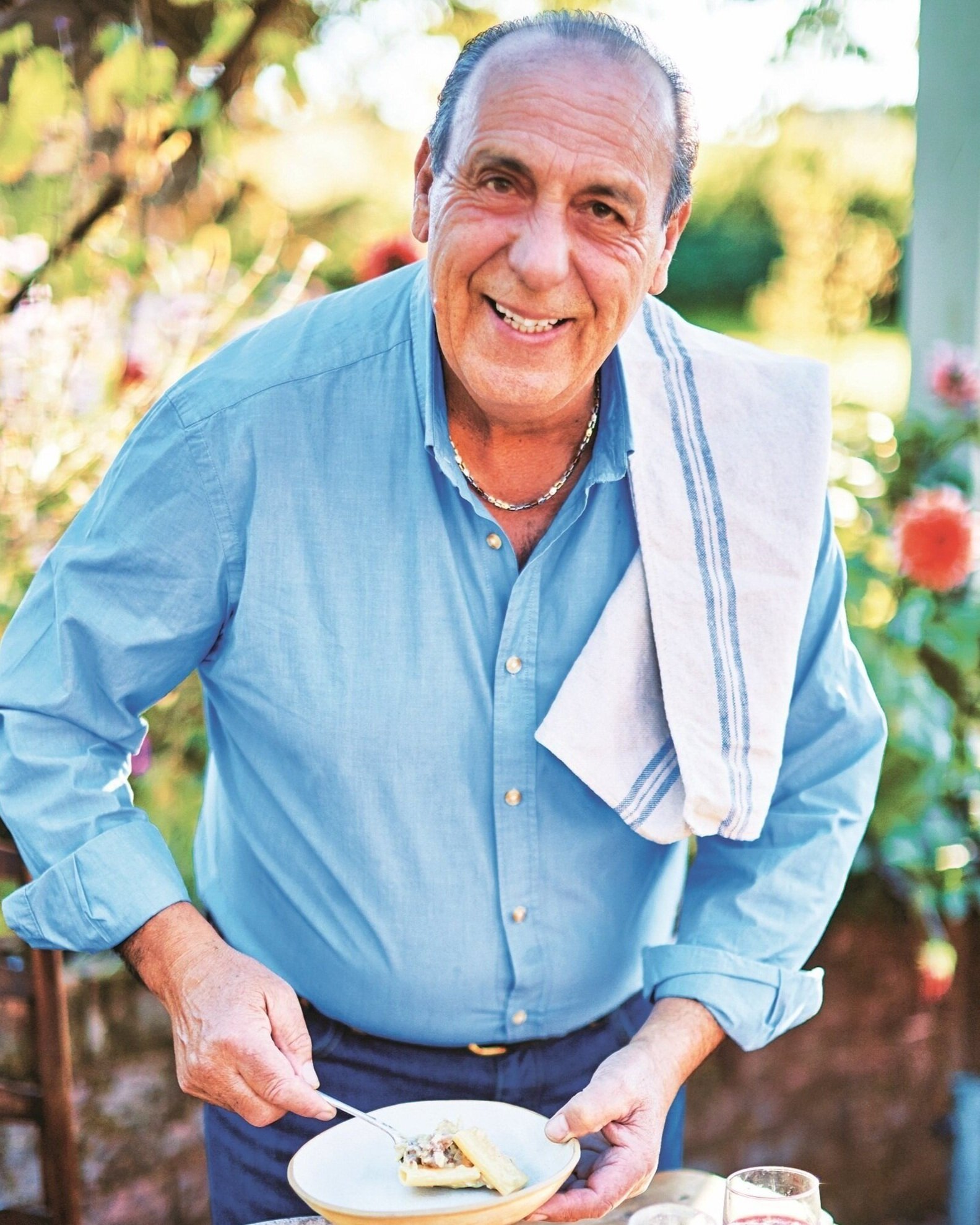Chatting to the big cheese of Italian cooking: Gennaro Contaldo on Parmigiano Reggiano
Though Gennaro Contaldo has lived in Britain for more than fifty years, he has not lost his taste for his homeland’s incredible recipes, nor for its incredible produce. Having been in the kitchen since a very young age, and going on to run award winning restaurants in London and become a staple of the small screen in programmes such as Two Greedy Italians and Saturday Kitchen, he is to countless viewers and aspiring cooks the epitome of everything great about Italian food, its bold flavours and comforting quality perfectly complementing his personality.
Parmigiano Reggiano is another Italian icon which has found a home in Britain. Samuel Pepys famously buried his cheese during the 1666 Great Fire of London, so valuable was it to him. Indeed, Gennaro jokes to me that they make wheels of the cheese so large because they would be harder for people to steal. Though still highly prized, it is widely available to UK consumers, keep an eye out for the Protected Designation of Origin (DOP as it is abbreviated in Italian), which means that it has been produced within the provinces of Parma, Reggio Emilia, Modena, in the part of Mantua to the right of the Po River, and in the part of Bologna to the left of the Reno River, and it has to be matured for a year at least. There are over three hundred active dairies in this area, producing almost four million wheels of the cheese a year.
Whilst the legal parameters of what can and cannot be counted as Parmigiano Reggiano are relatively recent, its history is much more ancient, nearly a thousand years old, when monks developed a cheese using milk from the cattle they kept which could be preserved for longer. This measure, which began as a means to store milk, resulted in a unique, aged flavour. At some point in the middle ages this regional speciality began to be exported further afield in the country which was yet to become Italy, and the rest is history. Natural milk, salt and rennet combined to make something which can completely transform a dish – it’s the addition of skill and time which makes it such an incredible ingredient.
There are probably few people in the world who have used more Parmigiano Regginao than Gennaro, and interviewing him, I find him to be every inch as passionate about great food over Zoom as he is on television:
What was it like visiting one of the dairies where Parmigiano Reggiano is made and seeing everything that goes into making this iconic cheese?
‘This dairy uses over a thousand litres of milk to make ninety to one hundred kilos of cheese, but they never chuck anything away. The whey that is left they bring up to simmer and you get this ricotta, and the water that’s left is given to the pigs. They look after all the cattle they have there so incredibly well – you call them and they come to you, they’re like a pet dog and you give them a stroke. I was at the Fattoria Rossi dairy and I saw the big boss, and he used to lean on the cow and stroke them like a horse and tell me her name and how many years she had been with them. They’re such happy animals. Over the generations, from nonno to grandson, the cheesemakers have been using the same recipe, every day they taste it they say it’s better: it is better, but it’s exactly the same! I’ve travelled everywhere, eating incredible food, but if you give me one little piece of Parmigiano Reggiano it would make me the happiest man in the world. The cheese is cared for so much: they hit it with a hammer and listen to how it sounds to check if it’s good – I tried, but you need years of experience to hear the vibrations. Each piece is so well looked after it’s unbelievable.’
You grew up in Minori on the Amalfi Coast, in the south of Italy, whereas Parmigiano Reggiano is an iconic product of Emilia Romagna in the north, do you think there’s culinary animosity between the two, or do you think they can be unified?
‘I grew up with Parmigiano Reggiano – I’ve been working in a kitchen from the age of ten, and it was always there. It moved from north to south so easily, you don’t notice it. Because it’s an Italian cheese, for all Italians it is very close to the heart.’
He holds a sizable wedge aloft: ‘This is Italy! I remember the pizzaiolo in Napoli putting a drizzle of olive oil over the pizza and a grating of the cheese. It’s like an old friend! I never throw away the rind of the cheese either – we cut it in pieces, and sometimes in Winter if you put it in your pocket it gets very near to your body and warms up a bit and you nibble on it, it’s like old American chewing tobacco! I keep a box of rinds: whenever I make soup or ragù I just put the pieces inside and they add so much flavour. I remember I used to go fishing, but the fish where I come from were so fussy, I used to have such arguments with the fish – I took the grated rinds from the deli and mixed with stale bread and milk, put it on the hook as bait: mullet love it. Oh my God! It was delicious – then you get a fillet of the grey mullet, put very fine slices of potato on top, as they do in Venice, and then butter and then Parmigiano Reggiano, then sage leaves. Layer it up, bake it in the oven. Oh my my! It’s good for the north, it’s good for the south.’
That surprises me, because I’m aware that quite a few Italians consider adding cheese to seafood to be almost sacrilegious…
‘We are very traditional in Italy: we know it’s good, but we can be stubborn – adding a bit of cheese is delicious. How can you eat prawns without the Parmigiano Reggiano?! Mix breadcrumbs with a few leaves of parsley and the grated cheese – sprinkle it on top: Alleluia!’
Outside of cooking with it or grating it over pasta, how else do you like to enjoy the cheese?
‘A simple apple with a bit of Parmigiano Reggiano, a little bit of olive oil, a little bit of balsamic vinegar, a few olives. Use a knife to break off pieces of the cheese, drizzle on the oil and vinegar – the bitterness of the black olives with sweetness of the apples and cheese, you put it inside your mouth…’
He then proceeds to do just that: ‘Sorry, I have to eat it,’ he murmurs, ‘this is when I say ‘why am I cooking so good?’ The simplicity is perfect.’
How might you eat a stravecchio (aged for two to three years) versus a vecchio (aged for a year and a half to two years)?
‘With a stravecchio, I have it with a very old bottle of red wine and some very rustic bread, it has such depth of flavour. With the vecchio you just break a piece off and eat it, but you have to be careful – you keep eating pieces and keep eating pieces until you realise you’ve eaten half a block of cheese.’
I have heard of some quite unusual flavour pairings with Parmigiano Reggiano, including serving it with coffee and honey…
‘I ate that one! Delicious! I was filming in Napoli, and a friend of mine said I should try this – he got a piece of the cheese, put some honey and ground coffee on it, I thought ‘what rubbish are you doing?’, I tried it – oh my God! That was good. In my new book about lemons I have a recipe for a lemon and Parmigiano Reggiano… ice cream. I remember with Antonio we used to do pecorino ice cream – Parmigiano is sweet, it has such an incredible flavour that works so well. There’s no end to what you can do with it.’
Speaking of the late, great Antonio Carluccio, and I was very struck by a really moving video you did, with over one million views now, where you cook the pasta al limone which you used to cook for him, indeed, when looking at so many of your recipes they really evoke your love both of the food and of the people you cook for…
‘It was very emotional – I was in Colombara, near Torino, by the rice fields. Years before we had filmed Two Greedy Italians there, and I told the producer that being there brought memories back, and we decided to film something quick, so I made the dish I used to make for Antionio. He was very dear to me, and I did cry. Each plate is an emotion. In the mind of a cook there are thousands of recipes, every time you change it a little bit. When I’m in my hometown, I make the dumplings my mother used to make, using ricotta, Parmigiano Reggiano, flour and egg yolks – cook them like gnocchi. She was from the old school, and I wonder what they used when they didn’t have the cheese, but I always remember Parmigiano Reggiano. Every single dish you should cook without being afraid – just do it. There’s one ingredient you must put in every time you do, and that is love, without that it never comes out properly. It doesn’t matter if you eat it and think ‘it doesn’t taste the same’, actually it tastes better, because your heart went inside the dish, and when you give it to everyone you express yourself.’
After the interview concludes we have a brief chat about what he’s been cooking recently (rabbit, as his father used to), he then signs off by telling me to stay safe, go out, eat lots of pasta, meat and vegetables – ‘but don’t forget – you need a little bit of cheese on top!’
Louis Thomas
Louis is fascinated by Italian cuisine and culture, particularly regarding the expression of regional identity through food. Whilst Italy is his greatest passion, he is interested in gastronomic history wherever he travels, believing that you can learn a great deal about a place from what's eaten there.
For more information about Parmigiano Reggiano: www.parmigianoreggiano.com
Follow them on Twitter @ParmesanUK and Instagram @parmigianoreggianouk
To see Gennaro visiting one of the dairies producing the cheese, click here: www.youtube.com/watch?v=6mS-PRzi2Io&t=94s




